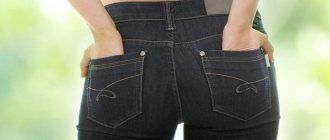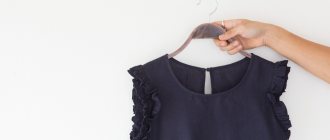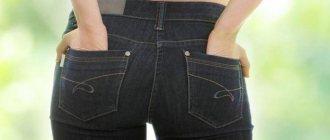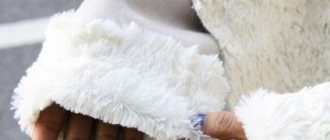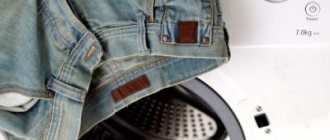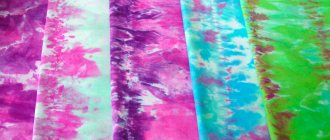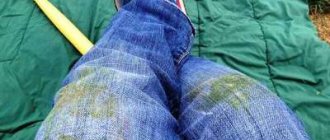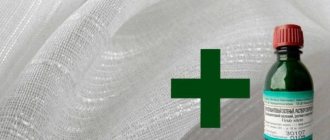Honeycombs
These characteristic elements form at the back of the knees, that is, where your legs regularly bend. Over time they become more and more expressive. The rate of honeycomb formation is influenced by your physical activity and the characteristics of the denim. Thus, in cyclists, “honeycombs” on jeans appear and develop faster than in those who walk in jeans.
It is worth noting that the most contrasting and expressive “honeycombs” appear on jeans made of heavyweight denim - especially those that have a fairly spacious cut.
Faded Honeycomb Jeans
Pocket fades
The term pocket fade in the USA and other countries refers to abrasions that form on pockets from the items that you put in these pockets. This could include wallets and other leather goods, phones or other electronic devices, pocket knives, lighters, cigarette packs, and so on. Corresponding abrasions can appear on pockets quite quickly. The speed of their development depends on the characteristics of denim and on how often and regularly you carry this or that item in a particular pocket, and how often you take it out of there.
Jeans with frayed back pockets
Lightening process
The dynamics of fabric lightening directly depends on how well it was saturated with the bleaching solution and how long this process lasted. If you regulate the access of reagents to certain areas of the tissue, you can obtain original patterns and stains.
Slight brightening effect
You can create partial lightening on an item without completely immersing it in liquid with bleach. For example, you plan to lighten the bottom of your skirt and get an ombre effect. Immerse the product in the diluted composition to the painting height. In order not to keep the item hanging, secure it on a stick or on a hanger. This way you will get a uniform blurred edge using the ombre technique.
The longer you leave the item in the solution, the more the colors will fade. Adjust the intensity of the dyeing process and remember that dried fabric will look lighter than wet fabric.
The effect of lightened stains
Beautiful lightened stains are obtained if you first twist the jeans tightly and secure them in this position with elastic bands. The bleaching liquid will penetrate unevenly into the structure of the fabric and will brighten the areas of the fabric that are “outside” more strongly. The material inside the resulting folds will be least susceptible to staining.
After washing and drying, beautiful horizontal stains with smooth, blurred boundaries are obtained on the fabric. To whiten vertical stripes, securely hold the jeans in certain areas with clothespins or paper clips.
Bleaching threads on pants
If you have jeans with a ripped effect and multiple horizontal threads, you can only dye them
It will look original and attract the attention of others. To prevent the fabric from staining on the back side of the item, place a protective layer of foil or other dense material inside the item.
Blot the threads with bleach, leave for the required period of time, rinse and dry.
On torn pants, only horizontal threads can be lightened. It will turn out original and impressive.
Complete whitening
To achieve complete bleaching, maximum lightening of the item, boiling or very long soaking will help. The stronger the effect of the coloring composition, the more the structure of the thread is destroyed. The lighter the item, the easier it is to achieve maximum lightness.
You can get strong whitening results by boiling or soaking for a long time.
Fringe bleaching
It is better to bleach individual threads, such as fringe, by hand. This makes it more convenient to control the color change process. Cover the areas you don't plan to paint with tape. Blot the threads with the prepared solution using a kitchen sponge. Or spray from a spray bottle.
When the threads change color to the desired color, rinse the area of fabric in cool water, peel off the tape and dry.
It is better to bleach fringe on jeans or denim shorts by hand.
Creating drawings or patterns
Beautiful patterns are created using improvised means:
- If the fabric is pinched with clothespins or bobby pins before bleaching, the result is pointed stars.
- For blurry circles, pull part of the fabric with rubber bands or strong threads.
- Citric acid and stencils create original patterns on fabric, even if you don’t know how to draw professionally.
- A spray bottle or sprinkler will create beautiful drops, drips and splashes.
If you decide to decorate your jeans with patterns, you can get an excellent result using a stencil and citric acid.
Stacks
Stacks are the worn areas at the bottom of the legs. They may resemble a honeycomb. The formation of stacks occurs in the process of wearing jeans without cuffs and with a small “accordion” of folds. If you roll up your jeans, you should not expect the formation of abrasions such as stacks.
Faded Stacked Jeans
How not to spoil something
- Always test the bleach liquid on a small area of the fabric. Evaluate the result, check the quality of the threads after dyeing.
- If you are creating original patterns, do not use metal clamps to avoid rust stains.
- Do not exceed the permissible concentration of whiteness and the time the fabric remains in the solution. This destroys the fibers of the fabric, and there is a risk of ruining the item forever.
- If you use a lace to tie fabric, take a white one so that it does not bleed its dye onto your jeans.
- Do not boil items made from thin stretch fabric.
- Follow safety precautions! Remember, you are working with liquids that can cause injury and burns.
The whitening process is fascinating and gives free rein to your imagination. An ordinary, boring, boring thing can sparkle with new colors. It’s especially nice that whitening is inexpensive and easy to perform. Update to your heart's content!
Train tracks (“railway”)
Train tracks are long, narrow strips that run parallel to the outer seams of the legs (though sometimes at a slight angle). The “railway” on jeans does not always form, and its formation can take a lot of time. To speed up the process, you can iron the side seams before putting on the jeans.
Faded Railroad Jeans
How to bleach jeans with bleach or bleach
Pour a glass of bleach or other bleach containing bleach into a metal bucket of hot water. There should be enough water to submerge the jeans entirely, but not to the very edges. Mix thoroughly and place denim trousers in it. Set the bucket to boil. Don't forget to stir and make sure the jeans don't jump out of the water. Adjust with a stick.
Cook for a few minutes until the desired shade appears. It is not recommended to keep jeans in bleach for a long time, so as not to cause much damage to the fibers of the fabric. If you still don’t get the desired shade, then you need to add another glass of bleach. The approximate allowable exposure time for bleach on fabric is 15-20 minutes. If you overexpose an item in bleach, the material will become loose and will quickly fray and tear.
Then put on rubber gloves to prevent your skin from coming into contact with the bleach. Remove the trousers with a stick so as not to get burned, rinse them and wash them. This way you will get washed-out bleached jeans.
If you want to make stains on your jeans, then before putting them in water with bleach, twist the legs into knots, not tightening too much, so that there is a smooth color transition effect.
To create interesting patterns, fold the jeans and secure them in different places using clothespins or dye-resistant rope, as well as elastic bands. Clothespins are used to grab pieces of fabric, which will then remain unbleached.
You can treat jeans with a mixture of bleach from a spray bottle. Or apply the desired design with a brush. Or wipe the desired areas with a sponge and bleach. In this case, prepare the solution in a ratio of 1 part bleach to 3 parts water. Apply bleach to pre-soaked jeans. After a few minutes, rinse them thoroughly, preferably with running water, and wash.
If you want to add a worn effect to the highlighted areas, rub them with fine sandpaper.
Whiskers ("mustache")
These abrasions may vaguely resemble the “honeycomb” mentioned above. However, they are formed not in the area of the knees, but higher - and not on the back side of the jeans, but on the front. As a rule, the characteristic “whiskers” appear around the fly and often reach the very edges of the jeans; they are oriented more or less horizontally or at a slight angle. Mustaches often appear soon after you start wearing jeans, that is, faster than a honeycomb.
Faded mustache jeans
Handy tools for color restoration
If your jeans have lost their brightness, you can contact a dry cleaner to solve the problem. Professional coloring will help restore the desired shade, but the procedure will be quite expensive.
If this is not possible, you will have to solve the problem of how to return the color to jeans at home.
There are several methods, the effectiveness of which has been tested by time:
- Washing dark, fadeable items together is the easiest method. Old jeans should be soaked together with a new black item for a quarter of an hour. After this, both items are washed in a machine at a temperature not exceeding 40º and rinsed in cool water with the addition of vinegar to consolidate the result.
- When wondering how to restore the color of your favorite trousers, rarely does anyone think about regular cigarette tobacco. A small spoon of the dried plant is added to a liter of boiling water and left until the infusion has cooled. It is passed through cloth or multi-layer gauze several times. Dip a sponge into the resulting solution and use gentle, methodical movements to treat areas that have lost color. This method is widely used to restore paint on knees, front legs and pockets. After processing, the product should be dried thoroughly.
- When deciding what to do to restore the paint, you can soak the jeans in water with vinegar added at the rate of one large spoon for every liter. To obtain the optimal effect, the product must spend at least half an hour in the solution.
Using such simple and affordable products will help you update the shade of your trousers quickly and effectively. However, it should be remembered that the result obtained will only be temporary.
What affects the speed and nature of denim fading?
Firstly, the more active and often you wear jeans, the more you move in them, the faster they will fade and acquire a patina.
Secondly, the higher the density of denim, the faster (on average) it will fade and acquire a patina. In addition, there is a dependence on the durability of the dye used by the manufacturer. If you want your jeans to age impressively, you should not purchase models made from denim, which the manufacturer or seller characterizes with the term permanent indigo, meaning the use of a very resistant dye.
Thirdly, the speed and nature of denim fading depend on how you care for your jeans. Sometimes, in order to obtain the most contrasting patina, high-quality jeans made from “raw” denim are recommended to be washed six months (or even a year) after purchase, but in reality a lot depends on the frequency of wearing and your physical activity. You can wait six to nine months if you wear jeans a couple of times a week and don’t do physical labor from morning to evening, but if you wear jeans every day, then washing may be necessary within a month or two. Sometimes, as a guideline for the first wash, it is advised to consider the appearance of pronounced “honeycombs” and “whiskers” - if they appear, the jeans can already be washed. In addition, if the jeans begin to smell and/or if they have stains that cannot be removed with a brush, they also need to be washed.
How to restore color to jeans at home
There are many ways to restore the color saturation of your favorite things. But before the process itself, you should properly prepare your clothes.
Wash and dry your jeans before restoring. Pay special attention to contaminated areas.
If you do not prepare the item, paint or other products may not adhere well, resulting in dullness.
It is also important to decide which recovery method you will use. The color can be restored by hand washing or using a washing machine. After that, we move directly to the process.
Special dyes
To correctly and reliably restore the color of a product, store-bought dyes are used. These are usually substances with a chemical composition for cotton fibers. Using this method, you can highlight the advantages:
- do not cause allergic reactions;
- effective and quick results;
- simple and convenient.
There are also disadvantages - the tissue quickly deteriorates after the procedure. But if you use this method extremely rarely, you don’t have to worry about it.
The dyeing technology is as follows:
- Take a container that is heat resistant. Pour 10-15 liters of water. Pour in the coloring powder or concentrate previously dissolved according to the instructions.
- Place the container on the stove and put the jeans inside.
- We are waiting for it to boil. Sometimes we turn things over. This will help the jeans dye evenly.
- After 20 minutes, add a little salt. Cook for another 10 minutes.
- After the procedure, wash the jeans in warm water, then in cold water.
- Dry well.
The most effective dyes for clothes: Dr. Beckmann, Ideal Black Jeans, IDEAL MINI, Rit Dye Black.
Potassium permangantsovka
Many people wonder what to do if black jeans have lost their color.
Use potassium permanganate. Quite a simple but effective way:
- Take a deep container, preferably enameled.
- Mix water with potassium permanganate. We wet the jeans and immerse them in a container.
- We wait some time for the item to be painted over.
- For better effect, add a little salt.
- After the process, rinse the jeans with cold water.
- To consolidate the result, add vinegar. After rinsing, straighten the product and let it dry on a flat surface. You can put a towel underneath.
Wet products appear slightly darker than dry ones. Keep this in mind before removing your jeans from the container.
Hair dye
Ordinary hair dye will help give a new look to old jeans. To carry out the procedure, you need to stock up on the following items:
- a large basin;
- black paint - two or three bags will be enough;
- three percent table vinegar;
- salt;
- gloves to avoid getting your hands dirty.
To get three percent vinegar, take one glass of nine percent vinegar and dilute it with two glasses of plain water.
We perform the following actions:
- Don't forget to wear gloves.
- Mix the paint as indicated in the instructions.
- Mix the resulting slurry with water.
- We soak the jeans. We're waiting for an hour. To ensure uniform dyeing, you should turn the clothes over after a while.
- After an hour, take it out and rinse with cool water.
- Take cold water, add vinegar and salt. Soak again.
- After all, we wring out the jeans and dry them.
Washing Fading Clothes
There is an unusual way to restore the color of black jeans without harming them. This is machine washing with faded clothes. Take black clothes that have not yet lost their color. Then follow the instructions:
- We take two things and turn them inside out.
- Put it in the washing machine.
- We set the mode to forty degrees.
- Turn off the machine after thirty or forty minutes. Leave the clothes for 2-3 hours. This will enhance efficiency.
- Afterwards we finish the washing cycle in the machine.
- While rinsing, add 1 tbsp. vinegar and conditioner.
After completing the cycle, hang the products on the dryer.
Do not hang it on the balcony. Direct exposure to sunlight will cause your jeans to become dull again.
other methods
It is possible to return the color of your favorite item in other ways. An excellent option is acrylic paint. It is important to approach the process with caution, as this can ruin the item. The acrylic substance dissolves well in water and is absorbed into the product, which helps restore it to its former saturation.
After the procedure, ironing will help fix the color. It is necessary to iron from the inside out, placing a layer of paper.
Regular tobacco is also used to restore saturation:
- Take a teaspoon of tobacco and pour 1 liter of boiling water.
- We wait until the liquid cools down.
- Strain through double-layer gauze.
- We wet the sponge with the solution and go over the item.
- You should not process one place for a long time, this can damage the fabric.
Vinegar will help you cope with the problem. To do this, add a little vinegar during washing, which will return a beautiful and rich black color. A tablespoon of vinegar per liter of water is enough.
